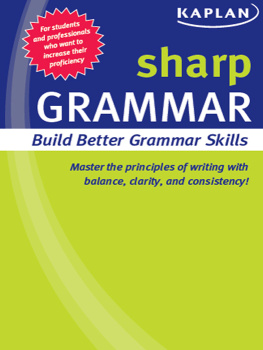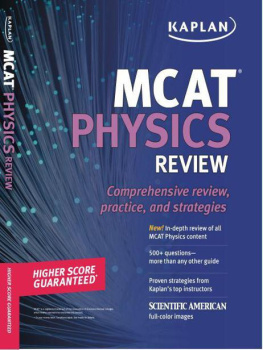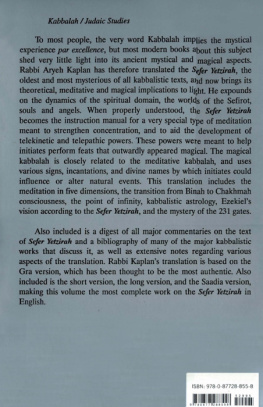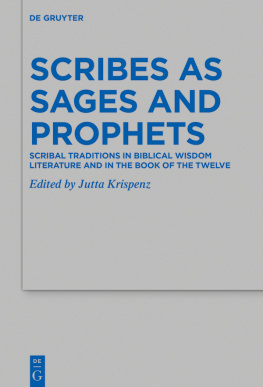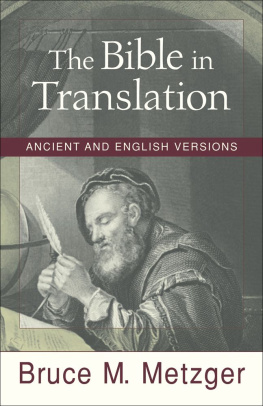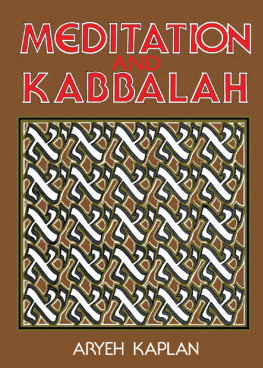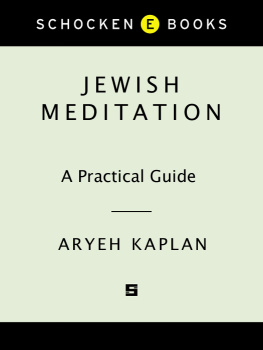

First published in 1978 by
Samuel Weiser, Inc.
P. O. Box 612
York Beach, ME 03910-0612
www.weiserbooks.com
First paper edition, 1988
08 07 06 05 04 03 02 01 00
15 14 13 12 11 10 9 8 7
Copyright 1978 Aryeh Kaplan
All rights reserved. No part of this publication may be reproduced or transmitted in any form or by any means, electronic or mechanical, including photocopying, recording, or by any information storage and retrieval system, without permission in writing from Samuel Weiser, Inc. Reviewers may quote brief passages.
Library of Congress Catalog Card Number: 84-50350
ISBN 0-87728-617-5
CCP
Printed in the United States of America
The paper used in this publication meets the minimum requirements of the American National Standard for Information SciencesPermanence of Paper for Printed Library Materials Z39.48-1992 (R1997).
www.redwheelweiser.com
www.redwheelweiser.com/newsletter
Contents
ACKNOWLEDGMENTS
Dr. Perle Epstein.
Library of Jewish Theological Seminary of America,
New York, New York,
particularly to Ms. Susan Young
and Mr. Micha Falk Oppenheim.
Hebrew University Libraries,
Jerusalem.
Bodleian Library,
Oxford, England.
Biblioteque Nationale,
Paris, France.
British Museum,
London, England.
Biblioteca Apostolica Vatican,
Vatican City.
Columbia University Library
Manuscript Division
New York, New York.
Lenin State Library
Guenzburg Collection
Moscow.
Introduction
ONE OF THE GREATEST MYSTERIES of the Bible involves the methods used by the prophets to attain their unique states of consciousness. Almost all of the Bible was authored by these prophets while in such higher states, but virtually nothing is known about how they were attained. In the actual text of the Bible, very little is said about the methods, and the few relevant passages that do exist are difficult to understand and require adequate interpretation. But unless their methods are known, it is difficult to put the teachings of the prophets of the Bible in their proper context, and consequently, many other concepts found in this sacred book are apt to be understood inadequately.
There are dangers and pitfalls in any attempt to shed new light on the Bible, and throughout the years, people have attempted to read the most outlandish ideas into the sacred text. It is therefore most important to explore the classical Judaic traditions and commentaries to see if they shed any light on the matter.
In general, there are two methods through which one can attain a mystical state or a higher level of consciousness, meditation and drugs. While some writers have tried to demonstrate that the prophets engaged in drug experiences, there is no objective evidence, either from the Biblical text or from the classical literature, that such substances were involved.
With regard to meditation, the precise opposite is true. As soon as we learn to understand the vocabulary, we find many references in the literature to Biblical meditation, and as recently as two hundred years ago we find it discussed in detail. One reason why this is not generally recognized is because all of this literature is in Hebrew, and, since meditation is for all practical purposes no longer practiced in Jewish circles, the meaning of the vocabulary associated with it has been forgotten.
An important task of this book, therefore, will be to re-learn the vocabulary used in classical Hebraic literature to describe the various meditative methods. This is very important, since the most frequently used Hebrew word for meditation is generally not recognized as such, and most translators render it incorrectly, completely losing the meaning of relevant texts. Even individuals with otherwise excellent scholarly credentials often misinterpret important writings, not realizing that they are referring to meditation solely because the correct translation of the relevant words is not known.
In the first section of this book, we will explore the relevant terminology, quoting numerous sources which, in context, unambiguously demonstrate the meaning of these words. In this section, we remain on firm ground, not resorting to any conjecture whatsoever. It appears that the main reason why the meanings of these words is not generally recognized is simply because no one ever went to the trouble to systematically explore all the sources where they are quoted.
The role of meditative techniques becomes all the more evident when one realizes the great extent to which they are discussed in the Kabbalistic literature. Unfortunately, most of this remains in unpublished manuscript, but here also, there is enough published material to provide a clear picture.
In Kabbalistic literature, we find considerable use of mantra-type meditation, where one repeats certain phrases, syllables, or divine names over and over in order to attain a meditative state. Another important method is that of Unifications (Yichudim), where the individual meditates on certain mystical names and letters, combining and unifying them in a prescribed manner. All of this will be presented in a companion to this volume, entitled Meditation and Kabbalah.
In the second section of this book, we will explore the various prophetic methods and experiences, both from the Biblical text itself and from the viewpoint of its classical commentaries. As this is explored in a systematic manner, some insight is also gained into the meditative methods used by the great prophets of Israel.
Most speculative is the third section, where an attempt is made to reconstruct the Biblical vocabulary used to describe the various meditative and mystical states. Here we switch gears, moving from the teachings of the philosophers and Kabbalists to those of the great Hebrew philologists. A study is made, both from context and from comparative philology and etymology, attempting to identify and interpret the various words that the Bible uses to describe meditative methods and higher states of consciousness.
Due to the fact that much of the material in this book may seem somewhat controversial, we will clearly stress the extent that it is discussed in classical Judaic literature. Wherever practical, we will quote from the primary sources, often presenting them for the first time in the English language. All translations in this book have been made by the author.
It is hoped and intended that this brief study will open an avenue for further research into the meaning of the Bible, as well as the significance of the prophetic experience, which is its basis. While this treatment is far from complete, it should provide a key for those who wish to open the inner doors and further explore these mysteries.
ARYEH KAPLAN 23 Adar II, 5736
PART ONE
The Traditions
1
Internal Isolation
Many people are initially surprised to discover that meditation plays any role whatsoever in Biblical teachings. It is a subject not often discussed in this context, and many individuals who are otherwise knowledgeable in Biblical thought are hardly aware that numerous important classical Judaic commentators interpret certain passages as referring to meditative experiences. One important reason for this is that such practices have not been in use since the great Hasidic renaissance almost two centuries ago. Where the experience itself is not known, the meaning of words used to describe it also becomes forgotten, and the entire vocabulary is lost.
Next page

